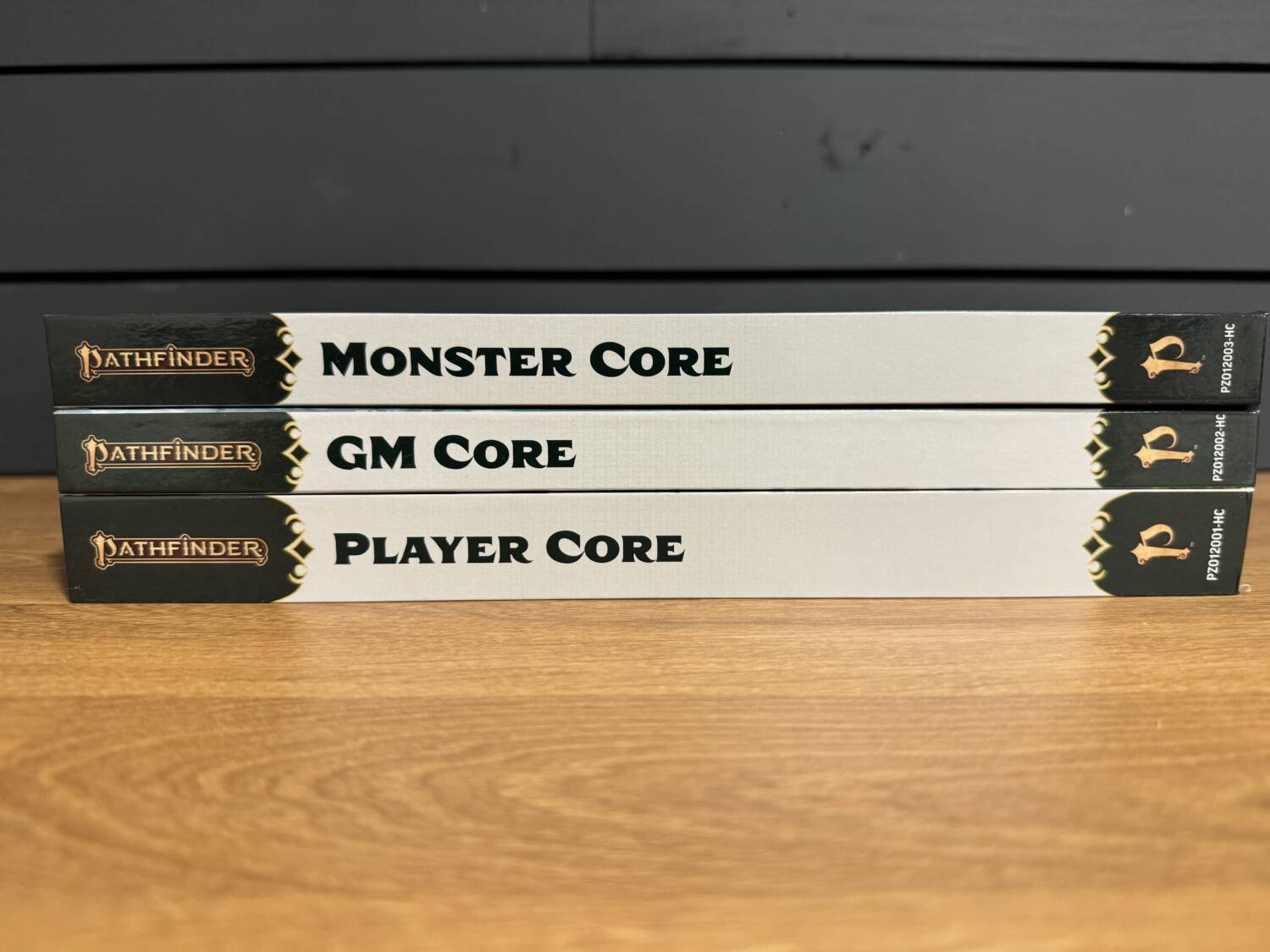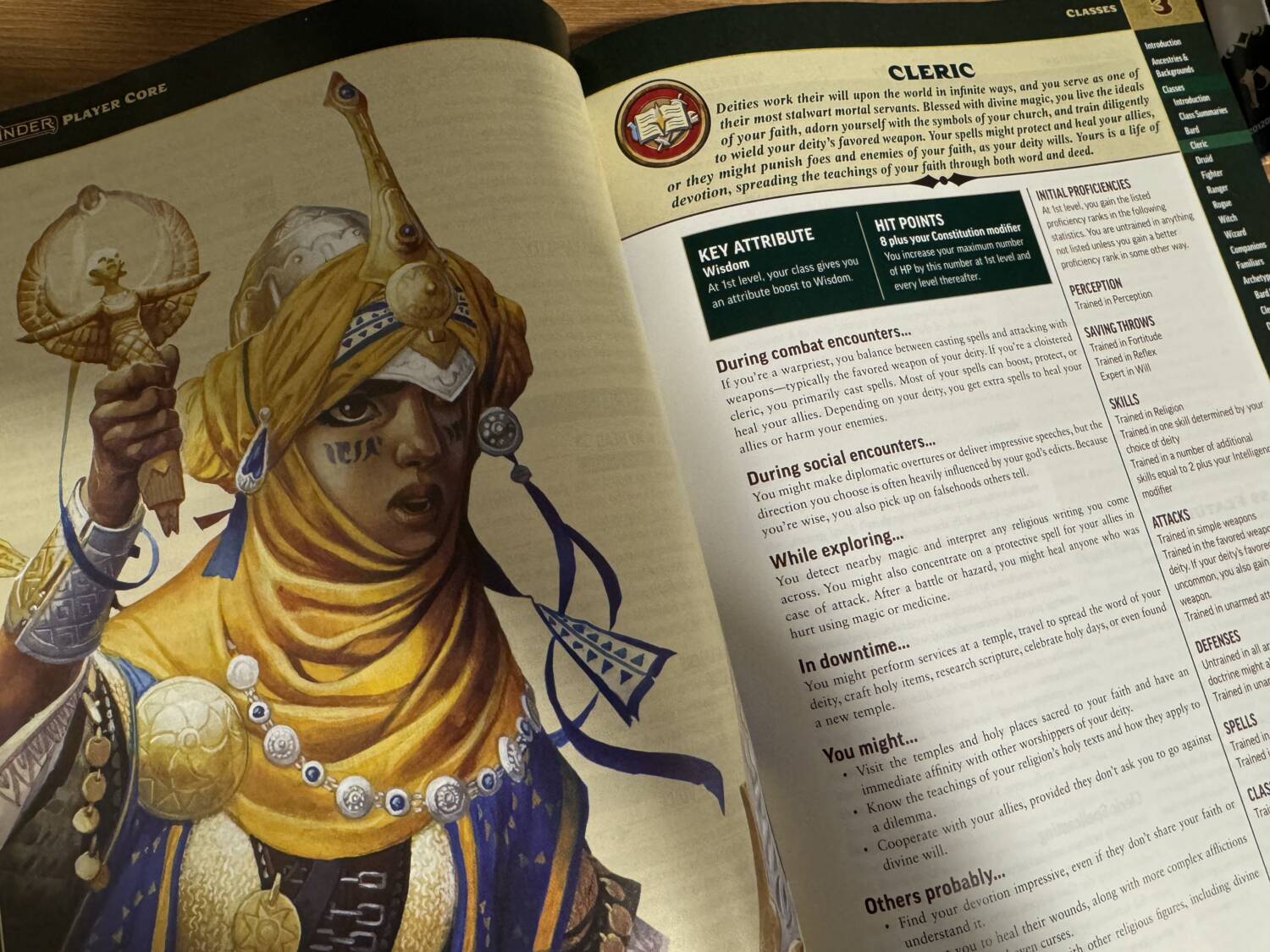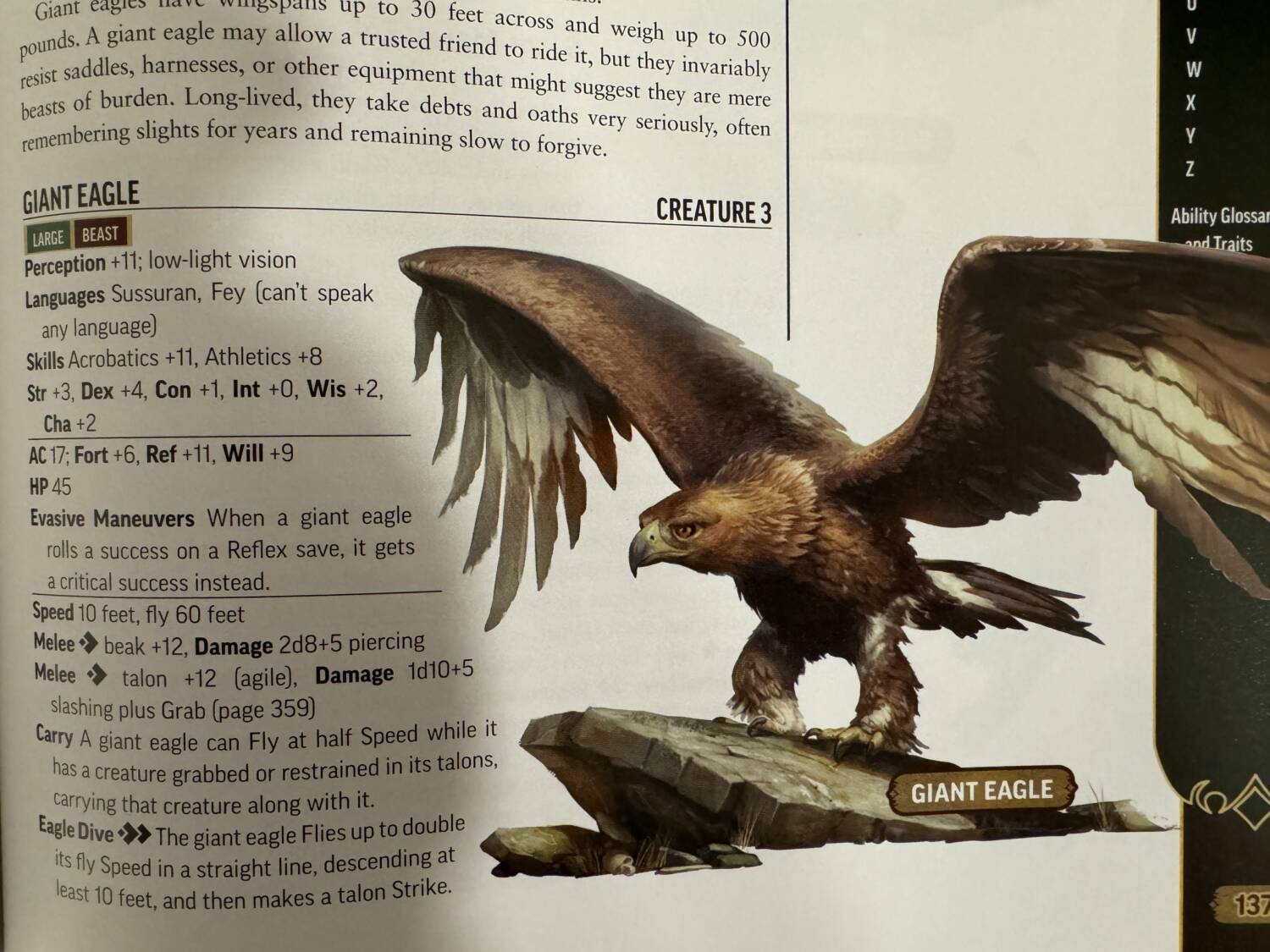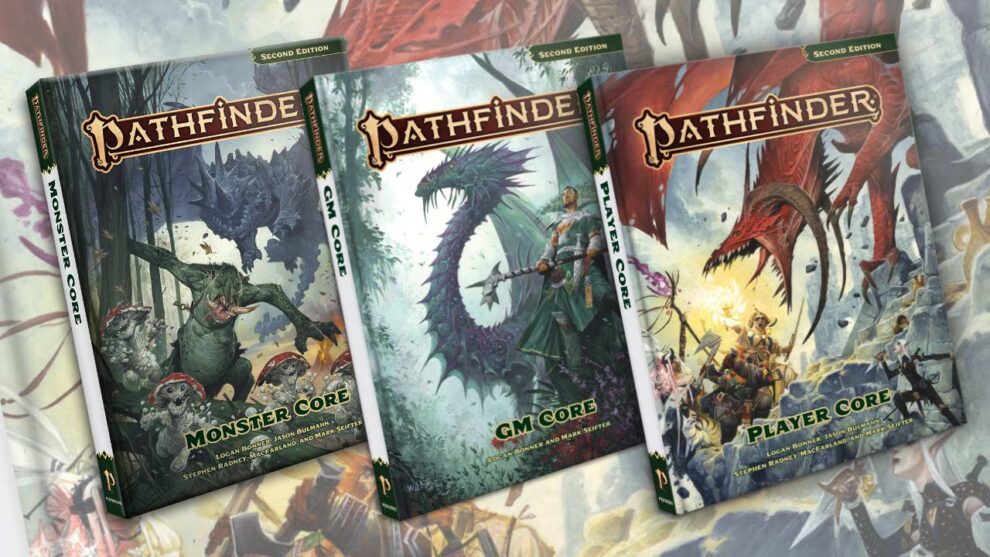Disclosure: Meeple Mountain received a free copy of these products in exchange for an honest, unbiased preview. This preview is not intended to be an endorsement.
For decades, the Open Gaming License (OGL) had allowed people to use the framework of Dungeons & Dragons to make their own systems, content, and adaptations to the juggernaut of tabletop roleplaying games. Unfortunately, Wizards of the Coast decided to release an updated OGL in 2023 that removed references to versions 3.0, 3.5, and 5.0 from being listed under community use. As a result, Paizo pivoted to create their own Open RPG Creative License (ORC) and remaster Pathfinder Second Edition to remove itself from the legal thumb of Wizards.
This debacle introduced a slew of content from Paizo as a part of the Pathfinder Remaster Project, including the new set of Core books designed to get you into the game. Instead of a single Core Rulebook and a Bestiary, the new Pathfinder Core now consists of three books: Player Core, GM Core, and Monster Core.

Pathfinder Player Core
The Pathfinder Player Core rulebook is the direct replacement for the original Core Rulebook and remains the bread and butter of the Pathfinder Roleplaying Game. For some people, this is the only book you may ever need if you prefer to play with a specific set of classes and trimmed down character options. It’s the framework of the entire game and the place to start as a new player.
From a layout perspective, the Player Core features a more minimalistic design that improves readability, especially when considering how many people access the content from a screen. The bold headings and clearly identifiable sections make the pages look less busy. I’m mostly thinking about the atrocious red sidebars from the Core Rulebook that are now non-existent. After you add in a hearty Index, looking up information manually is really effective.
One of the biggest changes is that the Player Core slims down to eight core classes: bard, cleric, druid, fighter, ranger, rogue, witch, and wizard. Sorcerer, champion, barbarian, and alchemist are out, instead brought back into the game with the Player Core 2 book. Although some people will be a bit miffed at the occlusion of these classes, there’s still plenty of versatility to be had in the current choices. Most of that is also thanks to the expanded list of core Ancestries, including the Changeling, Nephilim, and Mixed Ancestry options.
Don’t take this to mean that your character options are gone; there are still countless characters that you can create. The customization of characters is still wild to me, because of the range of feats across classes, ancestries, and general feats. There is something for everyone to enjoy and plenty of character concepts just waiting to be discovered.
As the driver of the Remaster Project was due to the OGL issues, the most extensive overhaul manifests itself as the removal of terminology that was traditionally born from the Gygax parlance. While I don’t have the space to list out all of the changes, there’s a very useful community-made spreadsheet here that helps with some of the specifics. In a nutshell: say goodbye to Magic Missile and welcome our new Force Barrage overlords.
One of Paizo’s strengths has always been in their method of introducing Character Creation to new players, and the Player Core does an even better job in this latest iteration. In 10 simple pages, every step is outlined for you, including an entire page walking through the process for an example character from start to finish. There’s a time for hand-holding and whether you’re creating your first character or your thirtieth, having a definitive process to follow is most welcome.
The last big departure is the complete removal of Alignment from Pathfinder. I’ve been in the ‘Alignment is Bad’ camp for a long while at this point, so I’m glad to see it go. More often than not, Alignment has been leveraged as a shoddy justification for behavior in Pathfinder—among other games—and it’s important to see characters as complex, dynamic beings. Alignment is much more diverse and fluid than that, and its removal is a worthwhile step in opening up characters beyond some rote categorization.
As a final note, the existing Pathfinder Second Edition content out there isn’t obsolete. Content from previous Adventure Paths, Lost Omens sourcebooks, and other player guides will all get eventually converted as a part of the Remaster Project. Feel free to continue to tap into those options with the understanding that they will likely change in the future.

Pathfinder GM Core
The Pathfinder GM Core takes a few elements originally in the Core Rulebook and combines them with content from the Gamemastery Guide to create this powerhouse of reference. As the name implies, this book is primarily geared towards Gamemasters, although that doesn’t mean that you should automatically discount it as a player.
There’s an entire section dedicated to the Age of Lost Omens, which is the current major epoch in Golarion history. All official Adventure Paths and scenarios are geared around this timeframe, creating a living history and worldscape that is constantly evolving. Lore-first sourcebooks are my biggest source of inspiration for characters and campaigns. Even though these sections aren’t nearly as detailed as the Lost Omens World Guide supplement—you’ll actually see some of the same artwork—they are a wonderful springboard for understanding the basics of the world. It also helps Gamemasters understand the general frame of reference that Golarion is built around.
The original Gamemastery Guide had a 40-page NPC Gallery in the back that was another fantastic resource for coming up with enemies or NPCs on the fly. Unfortunately, that has been removed completely so you’ll have to imagine your own using the Remaster changes.
You’ll also notice that the Variant rules section has been slimmed down by 80%, covering a sparse 4 pages. Some of the old options–like Alignment Variants–simply don’t apply anymore, and it seems like some of the others–like Ability Score Variants–are just rolled up into the general rules, albeit the latter being renamed as Attributes now.
I highly recommend taking a glance at the subsystems present in the GM Core, most of which were present prior to the Remaster. As someone who plays Pathfinder almost exclusively within a Paizo-structured Adventure, Module, or Scenario, these subsystems come up with more frequency and regularity than they did in First Edition. Paizo’s really been emphasizing originality in their published content instead of just stringing the party from encounter to encounter. In our current playthrough of the Sky King’s Tomb Adventure Path, I’ve had to reference the subsystems on multiple occasions and we’re not even out of Book 1 yet.
Lastly, I’ll point out that the GM Core has a much more expansive section on Treasure than the Gamemastery Guide, and it was converted primarily from the section in the Core Rulebook. My most referenced pages in this section come from the Weapon and Armor Runes, which are major progression items in Pathfinder Second Edition. It’s also important to note that the absence of the Alchemist in the Player Core doesn’t mean that Paizo skimped on the Alchemical Items—they are alive and well in full-detail in the GM Core. There are also plenty of magical items to throw at your players.
The important distinction between the GM Core and the Player Core is that the GM Core doesn’t include player options outside of equipment and treasure. From a general standpoint, I’d probably recommend other Lost Omens books for lore and really only recommend purchasing this one if you’re a forever-GM or really interested in some of the broader strokes of designing custom monsters and adventures.

Pathfinder Monster Core
The third book to round out the trifecta of Pathfinder Core materials is the Monster Core. Once again, Paizo is putting some space between them and Wizards by eschewing the common Bestiary nomenclature. Whereas I could make a case for the GM Core being a book that some players might want to pick up, the Monster Core is more strictly geared towards Gamemasters. It contains a hearty serving of creatures to pit against your players, along with some additional rules and recommendations surrounding them.
In terms of changes, most of the differences from Bestiary 1 are rooted in the aforementioned naming conventions. For example, creatures formerly known as mephits are now classified as scamps, and many of the angelic beings like Archons have been renamed completely as well. You’ll also find plenty of changes around dragons, which are no longer categorized by colors. Golems are also tagged as Constructs as opposed to having their own creature family designation, and gnolls are now kholo.
If you take a look at tabletop RPGs as a whole, there’s a lot of history to comb through, and most of the naming conventions are grounded firmly in people’s minds. Even Wizards’ unique monsters like beholders are sometimes inadvertently referred to when similar creatures pop up in games. Therefore, getting used to new names of things that have been around seemingly forever can take some time. Compared to many folks, I haven’t been playing these games for very long, so I don’t have as much neurological rewiring to do.
In any case, the Monster Core is a really solid foundation of creatures that will fit nearly any type of adventure that you want to run. Want to populate the crypt of an ancient noble family with ghouls, skeletons, and oozes? What about a forestal hunt to track down a legendary terotricus? Or maybe you just want to haunt your players’ dreams with an actual tooth fairy. Pathfinder flexes its creative muscles with classic favorites and their own interpretations of interesting and dangerous monsters.

Pathfinder Core: Worth Its Weight
The weight of these three books is staggering, since all together they’re clocking in at nearly 1200 pages of tabletop roleplaying goodness. But don’t think that you have to read them all cover-to-cover to start out. The structure of the books and the game lend itself well to using the books as a reference when rules cases come up that you aren’t familiar with. It’s all about learning in piecemeal.
The ORC license is a huge step forward in the industry, opening the door for creators to publish their own works through the Pathfinder Infinite platform without fear of the rug being pulled out from underneath them. It also ensures that Paizo can continue producing high-quality Pathfinder resources for many years to come.
You can stay current with the Pathfinder Remaster Project by following Paizo’s Release Schedule and searching for anything with Core in the title.











Add Comment